|
|
|
|
|
|
|
Achi-Kochi Japan
Showing many places to visit and foods to eat in Japan
|
|
|
|
|
|
|
|
|
|
|
|
|
Japan
> Hokuriku region
> Kanazawa
|
|
|
|
|
|
|
Kanazawa
Ishikawa Pref., Hokuriku ( Achi-Kochi Japan )
|
|
|
|
|
|
|
|
|
|
|
|
|
( "Achi-Kochi" in Japanese means "Here and there" in English. )
Kanazawa City, Ishikawa Pref., Hokuriku Region
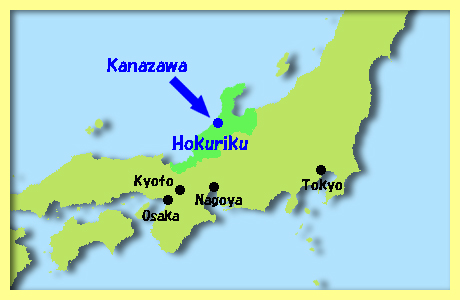
Kanazawa ( above ) is the capital city of Ishikawa Prefecture, located in the north of Hokuriku Region. The city had been the capital city of Kaga Feudal Domain, which had been the largest domain except the territories under the direct control of Tokugawa Shogunate while Kanazawa was one of the largest cities in Japan during Tokugawa Period ( ==> A History of Japan vol.2 Samurai Age ).
In addition, there had been no air raids in Kanazawa during WWII while most of the large cities were damaged by heavy bombing. So there in Kanazawa remain many historical things and sites relating to feudal lords and samurai vassals. Also in the fresh food market, some restaurants serve various seafood dishes.
|
|
Kanazawa-jo Castle and Castle Town

In A.D.1583, Kaga Feudal Domain was given to Toshiie Maeda, one of the famous warring lords in Sengoku Jidai ( Age of Warring States ) by Hideyosi Toyotomi. Then Toshiie Maeda made Kanazawa-jo Castle ( above ) his political and military center as well as Kanazawa became the capital city of the largest feudal domain.
When Toshiie Maeda entered Kanazawa, its population was several thousands. However He made his samurai vassals and their families live in Kanazawa, a castle town as well as merchants and craftsmen. So the city started to grow. Even after Ieyasu Tokugawa established Tokugawa Shogunate in Edo ( Tokyo now ) in A.D.1603, the Maeda family ruled Kaga Domain and Kanazawa continued to grow.
|
|
Kanazawa-jo Castle
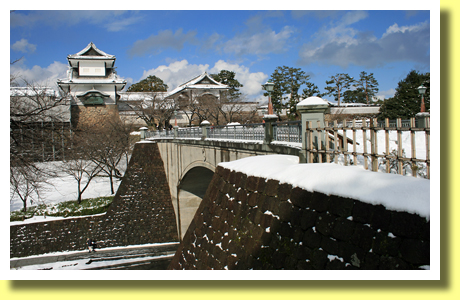
After Toshiie Maeda entered Kanazawa in A.D.1583, he made Kanazawa-jo Castle reconstructed in A.D.1587 and in A.D.1592. However in A.D.1602,
the main keep of the castle burnt down by the lightnig and has not been rebuilt. Furthermore the buildings of the castle burnt down several times.
In the site of the castle remain three structures including Ishikawa Gate ( built in A.D.1788 - above ), all of which are designated National Important Cultural Properties of Japan while a certain numbers of buildings have been reconstructed. Also the castle is one of the designated National Historic Sites of Japan.
|
|
Kenroku-en Garden
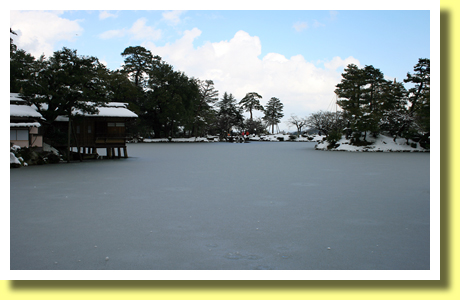
The most popular and famous site in Kanazawa City is Kenroku-en Garden ( above ), located near Kanazawa-jo Castle. Kenroku-en is one of the most beautiful gardens in Japan as well as Kairaku-en in Mito and Koraku-en in Okayama are.
Kenroku-en had been constructed by feudal lords of Kaga Feudal Domain for a few hundreds years. Kenroku-en had been a private garden until A.D.1874 in Meiji Period when the garden was opened to the public.
|
|
Kasumiga-ike and Kotoji-toro
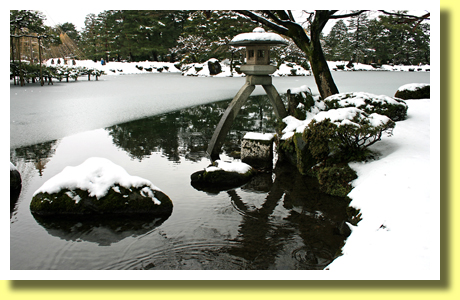
Many visitors walk around Kasumiga-ike ( pond ), at the bank of which Kotoji-toro ( lantern - above ) stands. Kotoji-toro lantern, with not one but two legs, is the most famous item in Kenroku-en Garden.
There in the garden are plum trees and cherry trees. So visitors could enjoy seeing their blossoms in spring as well as various flowers in summer. In autumn, leaves of maple trees would be coloured. Some people would prefer snow in the garden in winter.
Furthermore the garden has many more to see such as waterfalls, small hills, fountains, ponds, teahouses and bridges.
|
|
Seison-kaku Villa
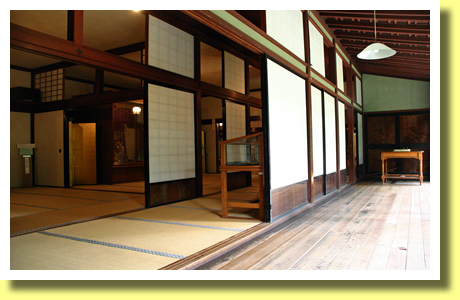
Seison-kaku ( above ), located in the southwest of Kenroku-en Garden, is a villa built by Nariyasu Maeda, the 13th feudal lord of Kaga Feudal Domain in A.D.1863 for his mother. The villa is one of the designated National Important Cultural Properties of Japan.
|
|
Garden of Seison-kaku Villa

Seison-kaku Villa has a beautiful garden ( above ), which is designated as a National Site of Scenic Beauty. The building of the villa has the roof covering the viewing deck facing the garden.
|
|
Nagamachi Samurai District

After Toshiie Maeda, the 1st feudal lord, made Kanazawa the capital city of his large feudal domain in A.D.1583, he made his retainers and their families live in the city. In Nagamachi Samurai District ( above), located at the foot of Kanazawa-jo Castle, remain some samurai residences and historic atmosphere.
|
|
Nomura-ke Residence

Nomura-ke, open to the public, is one of the samurai residences remaining in Nagamachi Samurai District. The ancestor of the Nomura family moved to Kanazawa City as a high ranked samurai vassal with the 1st lord of Kaga Feudal Domain. In Nomura-ke, tourists could see swords, armour ( above ) and paintings as well as the garden.
|
|
Higashi Chaya-gai
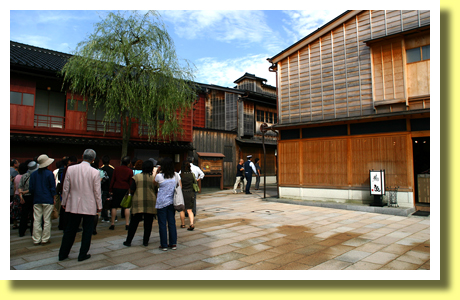
There lived many rich merchants in Kanazawa, the prosperous capital city of the largest feudal domain. They might have enjoyed in Higashi Chaya-gai district ( above ). There used to be many Chaya ( teahouses ) where customers were entertained by geisha girls while eating and drinking sake rather than tea.
In Higashi Chaya-gai distrcit, there remain almost one hundreds houses built a few centuries ago. Many of them are used as guest houses, restaurants, cafe and souvenir shops. Tourists could see geisha girls walking in the district sometimes.
|
|
Shima Teahouse
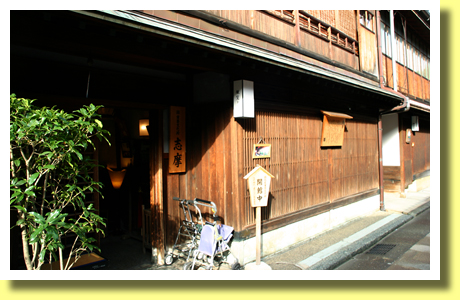
Shima Teahouse ( above ) is one of the teahouses located in Higashi Chaya-gai district. Shima Teahouse was built in A.D.1820 and is one of the designated National Important Cultural Properties of Japan.
Shima Teahouse is open to the public and tourists could walk inside the building while seeing rooms where geisha girls danced, sang, played shamisen ( three-stringed instrument ) and so on for their customers.
|
|
Oyama Jinja ( shrine )

Oyama Jinja ( shrine ), located to the west of Kanazawa-jo Castle, is famous of its unique Shin-mon gate ( above ), the 1st storey of which shows Japanese and Chinese elements while the upper storeys has a Dutch style with stained glass windows.
Oyama Jinja was founded in A.D.1873 to enshrine Toshiie Maeda, the 1st feudal lord of Kaga Domain. The Shin-mon gate, completed in A.D.1875, is one of the designated National Important Cultural Properties of Japan.
|
|
Omicho Ichiba ( Omicho market )
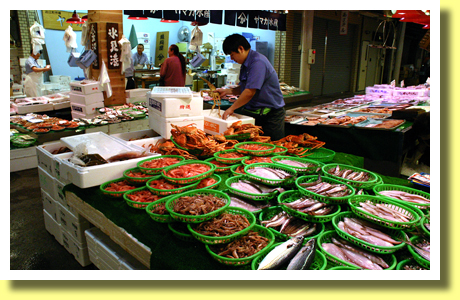
Omicho Ichiba ( Omicho market ), located one kilometer southeast of JR Kanazawa Station, is one of my most favorite places in Kanazawa City. There are almost 200 shops and stalls selling fresh local seafood ( above ), vegetables, flowers, fruit, pickles, seaweed and so on. Omicho Ichiba has been and is the most important market in the city since Tokugawa Period.
|
|
Kaisen-don
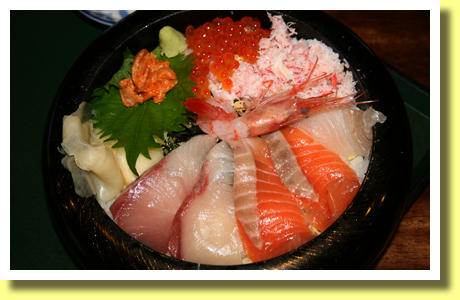
In Omicho Ichiba there are dozens of restaurants including seafood restaurants, some of which offer Kaisen-don ( above ). Kaisen-don is rice bowls topped with various fresh seafood. Kaisen-don would be suitable for tourists to enjoy various kinds of local seafood.
|
|
Sushi

Needless to say, there in Omicho Ichiba are some sushi restaurants which serve various kinds of sushi ( above ).
|
|
Hasumushi
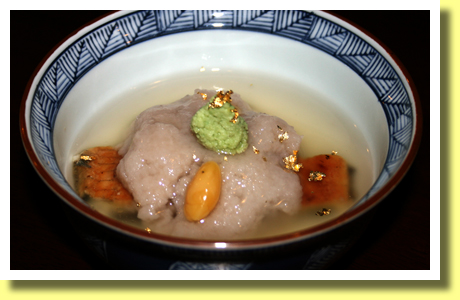
Not only fresh seafoods but also traditional local specialty dishes are served in some restaurants in Omicho Ichiba such as Hasumushi ( above ). "Hasu" in Japanese means "lotus root" while "mushi" does "steamed". "Hasumushi" is steamed dish of grated lotus root.
|
|
Jibuni
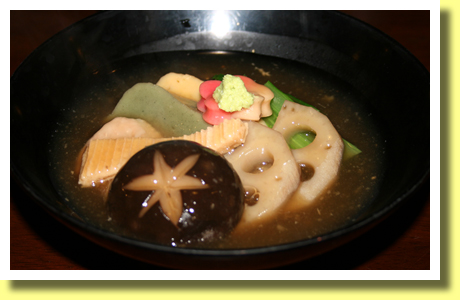
Also Jibuni ( above ) is famous traditional local dish served in Kanazawa. Jibuni is duck meat simmered with vegetables in soy and broth soup.
There are many more to eat in Kanazawa City such as Kaburazushi, sweet shrimp, sea bream, yellowtail, pufferfish, queen crab and snow crab as well as Japanese confections. In addition, sake produced in Ishikawa Perfecture would be so nice with local cuisine.
|
Copyright (c) 2021 Achi-Kochi Zanmai Co., Ltd.
|